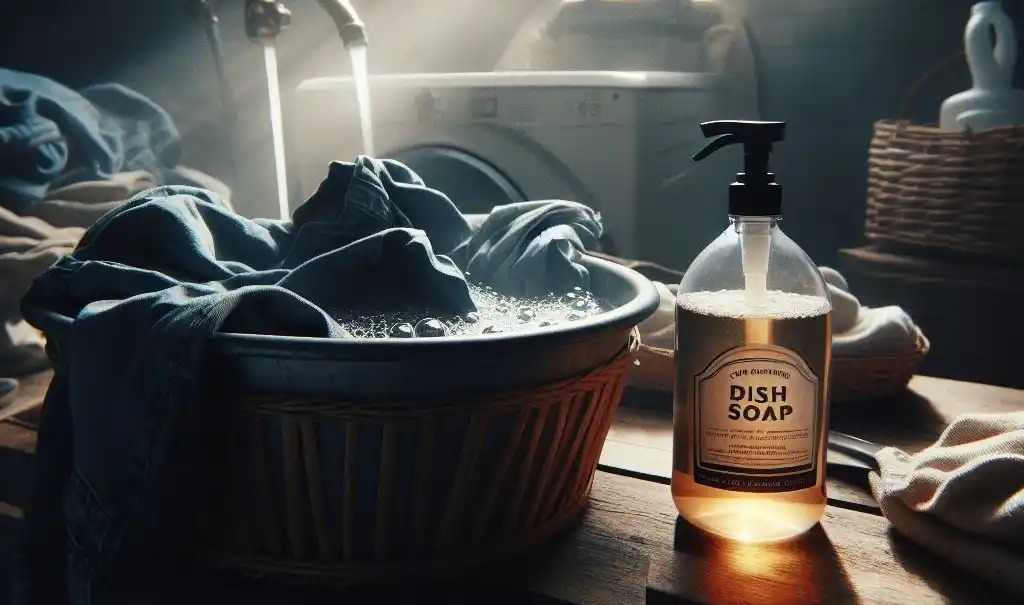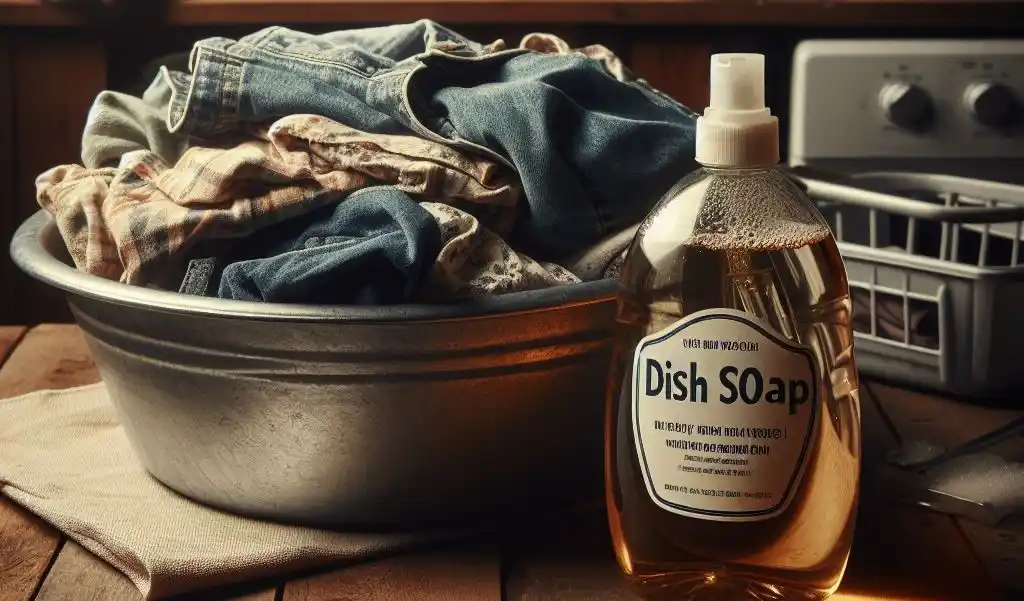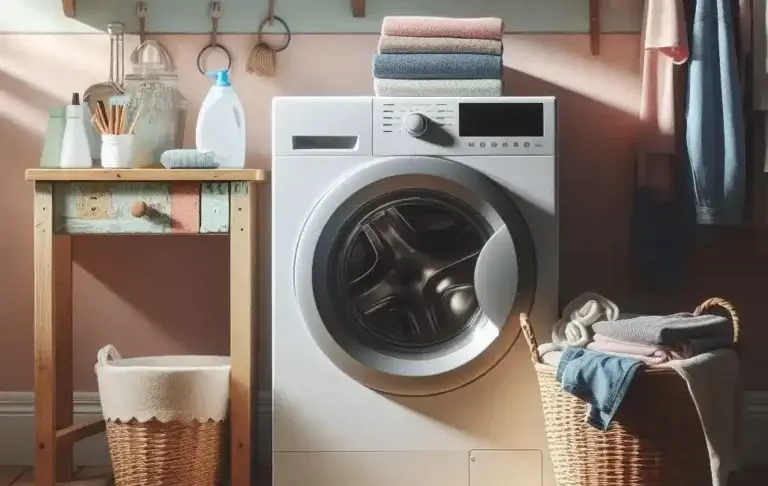Can Dish Soap Remove Stains on Clothes: A Laundry Hack
Have you ever gotten a stain on your favorite shirt that just won’t come out no matter how much you wash it? Those oil, grease, and food stains can be so frustrating to remove. Well, you’re in luck because there’s an inexpensive household item that works wonders on stained clothes: dish soap.
Keep reading to learn can dish soap remove stains on clothes why dish soap is an effective stain remover and how to use it to get even the toughest stains out of fabric. You’ll also find tips on pretreating stains and what not to do when using dish soap in laundry. With this handy laundry hack, you can stop worrying about stains ruining your clothes.
Table of Contents
Why Dish Soap Removes Stains So Well
Dish soap like Dawn is specially formulated to cut through grease and dissolve oil. This makes it great for washing dishes, and it also makes it an excellent laundry stain remover. Here’s why dish soap is so effective at tackling stained clothing:
- Grease-cutting formula – The detergents in dish soap are designed to remove oil and grease, the main components of many stubborn stains.
- High surfactant content – Surfactants lower the surface tension of water, helping it penetrate fabric and loosen stain particles so they can be washed away.
- Low sudsing – Unlike laundry detergent that suds a lot, dish soap doesn’t produce many suds, allowing its grease-cutting ingredients to work directly on stains.
- Concentrated cleaner – Dish soap contains powerful degreasing agents at higher concentrations than most laundry detergents.
With grease-fighting strength beyond that of regular laundry products, it’s easy to see why dish soap is so popular for pretreating laundry stains. Keep reading to learn techniques for using it safely and effectively.
How to Use Dish Soap to Remove Stains from Clothes

Using a small amount of dish soap can help loosen up and remove many types of stains before washing clothes. Here is a step-by-step guide to pretreating laundry with dish soap:
1. Check Fabric Care Instructions
Check clothing care tags before using dish soap. While it’s generally safe for cotton and most washable fabrics, dish soap may damage silks or wools. Never use dish soap on dry clean-only clothing.
2. Mix Dish Soap With Water
Mix a small amount (a few drops to 1 teaspoon) of original blue Dawn dish soap per 1 cup of warm or cool water. Avoid using too much dish soap as it could leave residue or cleaning agent buildup on clothing.
3. Apply to Stain
Dip a clean cloth or soft brush into the dish soap mixture. Dab the mixture directly onto stained areas of clothing. Let it soak in for 5-10 minutes.
4. Work Into Fabric
Gently rub the dish soap solution into the fabric using a soft-bristle brush or washcloth to help break up stain particles. Take care not to damage delicate fabrics.
5. Rinse Thoroughly
Rinse clothing under cool running water until all soap residue is removed. It may take several minutes of rinsing to remove all dish soap.
6. Wash as Usual
Wash clothing in the washing machine using detergent and the warmest recommended water temperature. The heat helps set stains so they don’t return. Repeat stain treatment if needed.
Be sure to thoroughly rinse dish soap from clothing as leftover residue attracts dirt over time. When used properly, though, dish soap can be a laundry miracle worker.
What Kinds of Stains Can Be Removed with Dish Soap?

Dish soap can tackle all types of oil-based stains including:
- Cooking oil and grease stains
- Butter, shortening, and lard stains
- Salad dressing, sauce, and gravy stains
- Motor oil and automotive grease stains
- Lipstick, lip gloss, and makeup stains
- Crayon, oil pastels, and candle wax stains
- Baby formula, poop, and spit-up stains
It also helps remove stains from:
- Mustard and ketchup
- Wine, coffee, tea, and fruit juices
- Chocolate and ice cream
- Dirt, mud, and grass
Dish soap even eliminates tough odors lingering in clothing from foods, sweat, and smoke. But remember – always check fabric care tags before using dish soap because it may damage delicate materials like silk or wool.
For some extra stain-fighting power against intense stains, mix dish soap with other homemade cleaners like vinegar or hydrogen peroxide.
Dish Soap Stain Removal By Fabric Type

You’ll need to use dish soap a bit differently depending on the type of fabric you are working with. Here is how to remove stains with dish soap based on 4 common fabric varieties:
Cotton and Linen Items
Cotton and linen fabrics are highly durable. Pretreat stains on cotton shirts, pants, linens, and towels by applying a mix of 1 teaspoon Dawn + 1 cup water directly to the stain. Let sit 5-10 minutes then launder as usual with detergent in hot water.
For stubborn stains on white cotton and linens, boost your dish soap by adding 1 tablespoon of baking soda or 1⁄2 cup of lemon juice or white vinegar to the pretreatment solution. After soaking the stain, wash items in hot water for best results.
Silk and Wool Items
Avoid getting cotton dish towels wet when cleaning silk and wool clothes. Mix a very diluted solution of a drop or two of Dawn per 1 cup of water. Use a clean spoon to gently apply it only to stained areas of silk or wool. Rinse immediately under cool water and air dry. Repeat if needed, then have it professionally cleaned. Never machine wash soap-treated silks or wools.
Polyester and Synthetic Items
The chemicals in dish soap can damage man-made fabrics, causing them to become misshapen or fade over time with repeated exposure. For poly-cotton blends, use the least amount of diluted dish soap necessary. Rinse thoroughly before machine washing with cold water and low-heat drying.
Delicate and Special Care Items
Check clothing tags to see if an item can be hand or machine-washed before attempting dish soap stain removal. If an item is dry clean only or marked delicate, head to your local dry cleaner and see if they can treat and remove the stain for you.
How to Dry Laundry After Using Dish Soap
It’s important to thoroughly rinse dish soap from clothing because most dish detergents contain chemicals and fragrances that can irritate skin. Follow these laundry drying guidelines after pretreating stains with dish soap:
- Shake and hang dry soap-treated clothes if possible. This allows fresh air to naturally remove any lingering odors or chemicals.
- Machine or air-dry cotton, linen, poly-cotton blends, and sturdy fabrics at low to medium heat.
- Lay flat to air dry delicate fabrics like silk, wool, spandex, rayon, or special care items instead of putting them in the dryer.
To play it extra safe, run rinse-only cycles after washing soap-treated clothes. An extra rinse helps remove any remaining residue.
Other Ways to Use Dish Soap on Laundry
In addition to removing stains on clothes before washing, dish soap can be used to hand wash delicate items and give laundry an extra clean boost.
Hand Washing Delicates
Add a small dab of original blue Dawn and a drop of white vinegar to a sink or basin filled with cool water. Use this sudsy solution to soak and gently hand wash delicates like silks, lace, and specialty fabrics. Rinse thoroughly.
Laundry Booster
For especially dirty loads like sports uniforms, greasy shop rags, or sweaty workout wear, add 1⁄4 cup of Dawn to your regular detergent in the washing machine. The extra grease-cutting power will leave clothes extra clean. Use only on durable cotton, denim, and linen items.
Stain Stick
Make a homemade stain removal stick by mixing 2 parts of Dawn dish soap with 1 part of baking soda. Scoop the paste into an old glue stick tube or empty lip balm container. Apply it directly onto stains as a pretreatment before washing.
What Not to Do When Using Dish Soap on Clothes
While dish soap is generally considered safe for laundry stain removal, take care to use it properly. Here’s what not to do when pretreating clothes with dish soap:
- Don’t use lemon or antibacterial dish soap varieties which can damage fabrics. Stick to the original blue Dawn.
- Don’t rub it vigorously on clothes as this can cause pilling or tears.
- Don’t leave dish soap soaked into fabric too long before rinsing as it can become nearly impossible to fully remove.
- Don’t put dish soap directly into the washing machine with clothes as too many suds may damage the washer.
- Don’t add dish soap to laundry loads containing non-colorfast fabrics as the chemicals can cause dyes to bleed.
- Don’t dry fabrics that haven’t been thoroughly rinsed free of dish soap.
Using too much dish soap or leaving residue in fabric increases risks like skin irritation, premature wear, discoloration, and foul odors. Stick to small amounts and rinse, rinse, rinse!
Laundry Stain Removal Tips & Tricks
Here are some extra tips to make your clothing stain treatments more successful:
- Apply stain treatments as soon as possible after a stain occurs because the longer it sets, the harder it’ll be to remove later on.
- Check clothing tags and test treatments on hidden seams when working with specialty fabrics to ensure colors don’t bleed or fabrics don’t shrink or warp.
- For fresh grease stains, sprinkle some baking soda or cornstarch on to absorb the oily residue before applying a dish soap cleaning solution.
- Use distilled white vinegar or lemon juice mixed with dish soap to help remove old, set-in stains on durable white fabrics. The acid helps break down stain compounds. Caution: Don’t attempt this technique with colored fabrics as the acid can remove dye along with stains.
- For stains on collars and cuffs, rub a small amount of undiluted dish soap into the fabric using an old toothbrush before rinsing and washing. The firm bristles combined with concentrated soap power to help break up stain residue.
- Alternate dish soap with laundry stain sprays like Shout or OxiClean to tackle stubborn set-in stains. The enzymes and oxidizers work in tandem with dish soap to loosen and lift stains.
- For SUPER stubborn stains (we’re talking spit-up stains that have gone through the dryer), try squirting some hydrogen peroxide on the stain before applying your dish soap cleaner. This combo bubble attack has removed many impossible-looking stains for us!
Don’t be afraid to experiment with dish soap solutions and alternate cleaning methods to find what works best for your particular stain. With some time and elbow grease, you’ll be shocked just how many once-ruined-looking clothes can be rescued from the trash bin.
Have an arsenal of stain-fighting supplies ready for laundry accidents.
FAQs About Using Dish Soap on Laundry
Have some questions about using dish soap to pre-treat laundry? Here are answers to some frequently asked questions:
Is dish soap safe for HE washers?
Yes, you can safely pretreat laundry stains with dish soap even if you have a high-efficiency washer. Just be sure to dilute it and thoroughly rinse clothes before washing to prevent suds from overflowing. Never pour dish soap directly into an HE machine.
Can I add vinegar when pretreating with dish soap?
White vinegar is safe to mix with diluted dish soap as a laundry stain treatment. The acid in vinegar helps break down stain compounds. Just avoid getting the mixture on non-colorfast fabrics since the acid can lead to dye bleed. Rinse thoroughly after letting the solution sit on stains for 5-10 minutes.
What temperature should I wash clothes after using dish soap?
Aim to wash clothes in the hottest water that the fabric care tag recommends after stain treatment and rinsing – that means warm for some fabrics and hot for durable items. The heat will better set stains so they don’t reappear over time. Just avoid steaming hot water on delicate materials.
Is Dawn’s antibacterial soap ok to use?
It’s best to stick to original blue Dawn dish soap varieties without additives like antibacterial ingredients. These can be harsh and damage fabrics with repeated use. Simple classic Dawn dish soap works fabulously to pretreat laundry stains without risks.
Can I wash clothes with dish soap instead of laundry detergent?
While dish soap in small amounts can remove set-in stains on laundry, you should not regularly wash entire loads with dish soap instead of specially formulated laundry detergent. The textures, chemicals, and levels of cleaning agents in dish soap make it unsuitable as a standalone clothing wash solution.
Have additional questions? Get in touch or leave a comment below.
The Takeaway: Can Dish Soap Remove Stains on Clothes
If you’ve stained a favorite shirt or dress, don’t panic – grab the original blue Dawn dish soap before you throw it in the trash! With proper dilution and application, dish soap can safely remove oils, greases, food spills, makeup stains, and more from clothes and fabric.
Just be sure to check fabric care instructions first, always mix soap with water instead of applying it directly, go gently on fabrics, rinse thoroughly, and wash on the warmest recommended setting afterward. Avoid repeated or improper use.
With some time and targeted effort, dish soap can eliminate stains and save clothes you thought were un-wearable. No need to discard that beloved t-shirt or your go-to work button-down thanks to this handy laundry hack!








